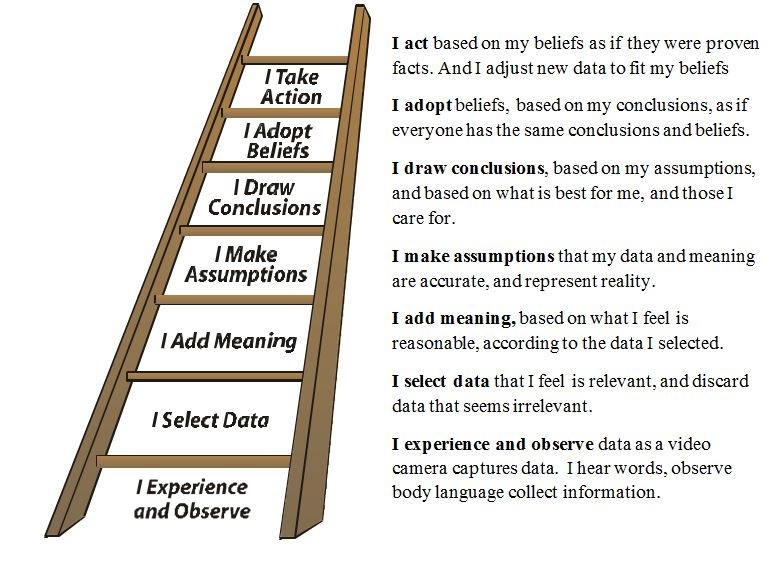How Distorted is Your Leadership Lens?

We all wear filters which affect how we perceive the world. Let’s call it our leadership lens.
No one is immune–even super smart people.
And there’s nothing wrong with that.
The challenge is for each of us to be fully aware of our filters and how they influence our leadership lens. Otherwise, our filters become so saturated that our view of the world becomes distorted, weakening our effectiveness as leaders.
Addressing how we perceive the world through our leadership lens helps make us more effective leaders because we’re able to remove the interference that can impedes our judgement. Let’s look at a fictitious example and a tool that can assist us in better understanding our leadership lens.
Mary grew up in a home where her father had strict views on women in the workplace. Men, in his view, were in charge of organizations, managed people and held public office. Women, in contrast, if they worked outside the home were in traditional roles, such as nurses, office assistants and teachers. Guys worked in the apprenticeship trades if they chose to, not women.

When finishing high school, Mary wanted to go to community college to study electronics, a three year program where graduates work as technologists. Her dad laughed at this notion, insisting that if she wanted to go to community college (as a university engineering grad he thought college was for dummies) that she study office administration. Her brothers agreed with their father.
Lacking confidence and confused, not only because of the lack of support from her family (her mom remained mute on the topic) but because of her high school guidance counsellor who had tried to point her towards a career in the social sciences, Mary decided to work for a few years after she graduated.
During her four years of working in various service sector jobs, Mary encountered a number of managers, both men and women, who practiced top-down managing. Employees, in her mind, were pawns to a means to an end. Mary began to establish a jaded view of what management and leadership represented to her: top-down decision making, do-as-you-re told, no engagement of employees, and compliance if you wanted to stay out of trouble.
Eventually Mary returned to school, earning a business degree at the age of 27. It took a few months to get a job offer in her field. Unfortunately, she discovered during her first year that her boss expected more of her than her male teammates, though she noticed that her one female co-worker, who’d been with the company for several years, asserted herself by standing up to the boss. “How’s she able to do that?” Mary used to wonder.

After a year Mary decided to job-hunt, but took her time to research companies and their reputations on how they treated their employees. Six months later Mary left her employer to work with a small firm led by a female entrepreneur named Rebecca.
What had impressed Mary during her job interview was Rebecca’s warmth and interest in her background and aspirations. While a straight-shooter and demanding of her employees, Rebecca also believed in coaching to help them reach their full potential. During an informal coffee chat one afternoon, Mary shared her views on leadership, going back to when she was growing up to her four years working after high school to her recent first job as a new business grad. Rebecca listened intently, not saying a word as Mary spoke for half an hour.
“Okay,” Rebecca said once Mary finished sharing her story, “I have something to show you which will help you understand why you hold a certain mental image of what a leader looks like, and your perception of leadership that it’s about authority.
We all have filters, Mary, which start being formed when we’re young. As we go through school as youngsters; interact with our parents, siblings and friends; attend college; and then enter the workforce our filters continue to develop. If we have a major traumatic event in our lives this can strongly affect our filters. One of the results is how we engage with others when we’re in the workforce. If we’re given managerial responsibilities then these filters will have a major impact on how we lead others. In short, our personal leadership lens can become quite distorted.
What I’m talking about is what’s called Mental Models, the set of assumptions we’ve established over many years based on our personal life experiences. They affect how we see the world, and in turn interact with and lead others.”

Rebecca started to sketch on a sheet of paper as she talked. “A fellow by the name of Chris Argyris, a professor of psychology at Harvard, developed the concept of Mental Models and a tool called The Ladder of Inference (see above). It’s a great tool to use to help people understand why and how they perceive the world as they do. Reflect back, Mary, on your upbringing, experiences in school and afterwards.
Briefly, here’s how the Ladder works.
On the first rung we capture data, as would a camera through its lens. This is our reality. We observe our parents, teachers, family friends, community leaders, etc.
From there we select data according to our experiences, any major events and emerging biases.
We then begin to assign meaning based on our interpretations of the second rung.
The meanings we’ve been forming cause us to develop assumptions.
Now, we’re beginning to draw our own conclusions as a result of our new assumptions.
Our conclusions lead us to adopt general beliefs about the world.
Finally, as individuals we decide to take action on our beliefs.”
At this point Rebecca leaned forward in her chair. “Mary, the key point to understand is that as a leader it’s vital for each of us to stop, pause and reflect on where we’re at in our leadership journey. Each of us needs to regularly revisit our assumptions and beliefs as they relate to others and society as a whole. If we allow ourselves to climb all the way to the top of the Ladder of Inference, then we’ve lost the ability to view the world in a more objective manner. Furthermore, it becomes that much more difficult to release those assumptions and beliefs.
“One final thought I’ll share with you, Mary, and it’s a hugely important one, is this:
Management is appointment to position; leadership must be earned.

Mary, if you have no followers you are not a leader. You need to enrol people in your vision if you want them to follow you. This is vital, especially for small companies like mine. We need to constantly innovate and explore new opportunities to seize and exploit. As the company’s leader, I can’t achieve that if you and your co-workers are not following me. Each of us needs to periodically re-examine our leadership lens as a check-in to how we’re interacting with the world: at work, in our community and at home.
Understanding the concept of mental models and the Ladder of Inference as a tool will assist you in your leadership journey.
So, Mary, does any of this help you in wrestling with your image of leadership, and in particular how you want to develop your career? You have a lot of leadership potential, and your co-workers have a lot of respect for you.”
“Wow,” Mary exclaimed, “your explanation really helped open my eyes to how I’ve created my own mental model of leadership. And I get just how important the aspect of followership is for organizational success. I’m with you, Rebecca.”
And with that Rebecca and Mary concluded their conversation and headed back to the office, with Mary totally energized with her new discovery and wanting to begin her journey into leadership.
The ability to perceive or think differently is more important than the knowledge gained.
– David Bohm (physicist)
Articles from Jim Taggart
View blog
My recent posts explored what it means to be a team, the five levels of teamwork, how to build perfo ...

The human race is an odd species. Adaptive to immediate threats and catastrophes, we as humans have ...

In my last post I talked about building team performance. Today, we look at what kind of team player ...
You may be interested in these jobs
-
Chargé·e de projets événementiels
Found in: Talent CA 2A C2 - 4 days ago
Société Traiteur Montreal, Canada PermanentSociété Traiteur est actuellement à la recherche d'un(e) chargé(e) de projets événementiel s pour rejoindre notre équipe passionnée. Le/la candidat(e) idéal(e) sera responsable de la gestion complète de divers événements, depuis la conception et la planification jusqu'à l'exécut ...
-
bookkeeper
Found in: Talent CA 2 C2 - 2 days ago
Al-Rahma Convenient and Halal Meat Ltd Edmonton, CanadaEducation: · Expérience: · Education · Secondary (high) school graduation certificate · Tasks · Calculate and prepare cheques for payroll · Calculate fixed assets and depreciation · Keep financial records and establish, maintain and balance various accounts using manual and com ...
-

Steward (Canadian Coast Guard Western Region - Fleet)
Found in: Talent CA 2 C2 - 2 days ago
Treasury Board of Canada Secretariat Victoria, CanadaYou will leave the GC Jobs Web site · The job opportunity you have selected requires the Public Service Commission (PSC) to transfer you to the hiring organization's Web site or a service provider Web site they have selected to advertise this process. · Select the link below to ...


Comments